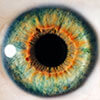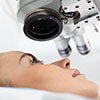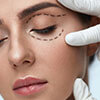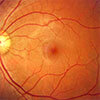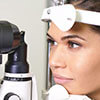Figure 1: Peripheral Corneal Ulcer
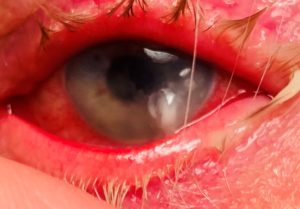
Figure 1: Peripheral Corneal Ulcer
One of the joys of living in the Pacific Northwest is the easy access to fresh water lakes, mountains, hiking and biking trails, and world class rock climbing. However, with the beauty, thrills, and jealousy inducing social media posts, come eye injuries filled with dirt, grime, and microbes. As a member of the cornea and refractive surgery team, a common appointment line on my schedule reads, “new patient, corneal ulcer referral.” We all know the patient. Maybe they’re a 25 year old mountain biker who sleeps in his contacts for days at a time, and thinks maybe he got some dirt in his eye over the weekend. Perhaps they’re a 65 year old woman, who was swimming in Lake Washington with her grandchildren on a coveted sunny day. We look behind the slit lamp, and we see a large, central infiltrate.
What we might not all feel comfortable with where to go from here. While most ulcers will respond well to empirical treatment with frequent, broad spectrum antibiotics (and a little steroid), there does come a time when more concrete information is necessary in guiding our treatment. In cases of vision threatening ulcers, corneal culturing becomes an essential tool in providing the best outcome for our patients.

Traditional culturing methods, involving swabbing the cornea to collect a specimen and streaking the sample onto nutrient agar plates, may seem cumbersome or impractical. Eye care providers often shy away from culturing due to a lack of confidence in technique and the logistics of storing the proper materials. “Quick cultures,” with use of a sterile swab and included culturing broth, certainly have a lower barrier to entry, but with this ease may come less frequent positive results.
The answer to our woes may be polymerase chain reaction. PCR is a rapid, highly sensitive method of identifying microbes by extracting and amplifying small samples of DNA. Over the last year and a half (and counting), we’ve all become familiar with the term in reference to viral respiratory cultures, but PCR has utility in ophthalmology as well. Collecting a sample is similar to “quick culturing,” with a sterile swab placed in a provided medium, which is then sent to the lab for analysis. Culturing kits are stored at room temperature, making it reasonable to have a few on hand in clinic. Results come quickly, typically within 24 hours of being received by the lab, and just one swab can include bacterial, viral, and fungal cultures, plus susceptibilities. This turn around time is particularly useful in cases of suspected fungal keratitis, where traditional culturing methods may take several weeks to yield final results. Downsides to consider include only testing for a limited number of pathogens and potentially cost; but hey, nothing’s perfect!
Figure 3: Organisms Tested by HealthTrackRx

Through a combination of thoughtful empirical treatment, traditional culturing, and PCR analysis, we can all feel confident handling these scary, all too common, sight threatening conditions. That way, we can get our patients out of our chairs, and back on the trails where they belong!
References:
- Robinson, Jessica. Et al. “Collecting a Corneal Culture.” Review of Optometry. April 15, 2016. www.reviewofoptometry.com/article/collecting-a-corneal-culture. Oct 13, 2021.
- Fairbanks, Aaron. Et al. “Culturing the Cornea.” org. University of Iowa Healthcare. Sept 26, 2016. webeye.ophth.uiowa.edu/eyeforum/tutorials/cornea-culture/index.htm. Oct 13, 2021.
- Kim, Elma. Et al. “Prospective Comparison of Microbial Culture and Polymerase Chain Reaction in the Diagnosis of Corneal Culture.” American Journal of Ophthalmology. Nov 2008, 146(5):714-23.
- HealthTrackRx PCR Testing, 2021. www.healthtrackrx.com/our-menus/. Oct 13, 2021.
 Author: Stacey M. Keppol, OD, FAAO
Author: Stacey M. Keppol, OD, FAAO
Specialty: Medical Eye Care
Working on the cornea and refractive surgery team at NWES has exposed me to a plethora of interesting cases of microbial keratitis. I chose to write about a lesser utilized, but effective tool in managing these patients. Like many of the individuals we care for, I enjoy spending my time participating in outdoor sports and recreation, and relate to the desire to get back to activities quickly. My goal is to help patients do that with efficient diagnosis and treatment of their conditions.



